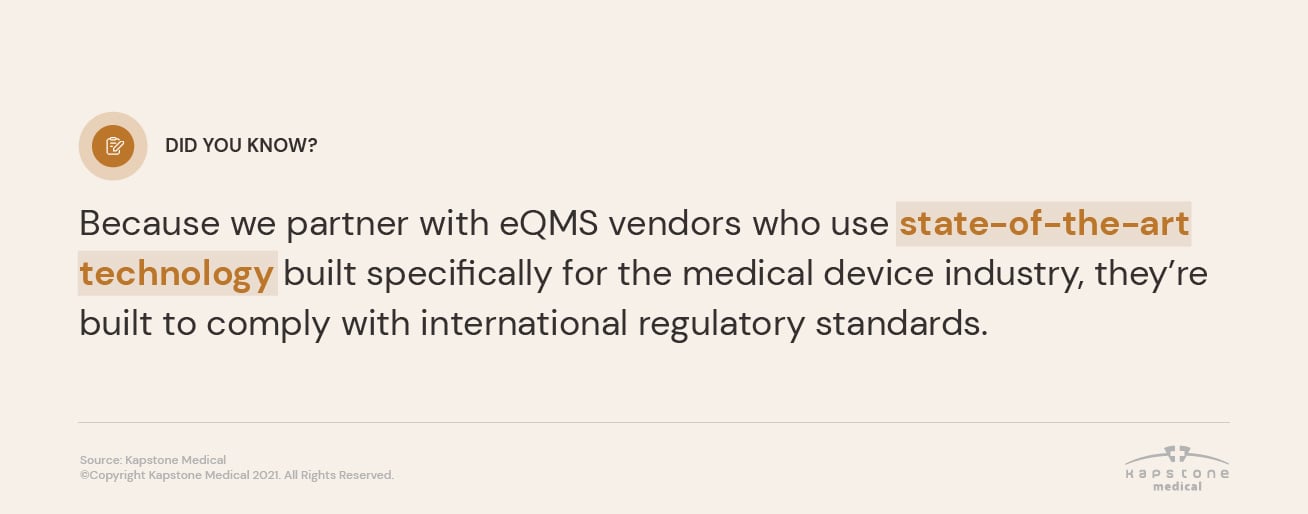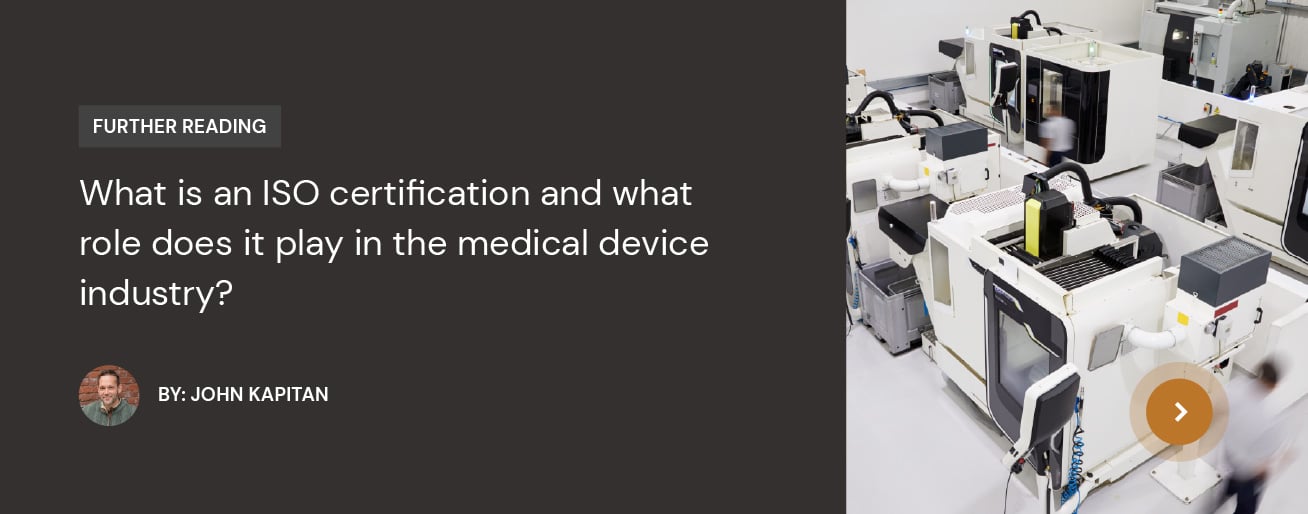No two companies can use exactly the same quality management system (QMS). These systems have to be designed with a company’s customers, markets, products, and business goals in mind—what works for one may not work for another.
However, there are QMS regulations and standards that all medical device companies should take into account. While their systems will still vary as much as the industry does, these companies can all benefit from the implementation of an ISO 13485-certified QMS.
ISO 13485 is just one of the International Organization for Standards’ (ISO) thousands of international standards. Earning an ISO 13485 certification for your QMS—or working with a partner that has earned one—proves that your company meets the international gold standard of quality in terms of customer satisfaction, regulatory adherence, and more. You can learn more about this standard and its role in the medical device industry here.
Kapstone Medical (and Kapstone Manufacturing) is proudly ISO 13485-certified. Whether you’re pursuing a certification yourself or just looking for a trusted QMS partner, we can help you meet and surpass these standards.
Upgrade Your QMS with Expert Guidance from Kapstone Medical
Most medical device companies already have some form of a QMS in place. It’s hard to validate any of your work without one! However, these systems are often rudimentary or incomplete—through no fault of the companies. Without years (or decades) of industry experience, it’s very difficult to understand all of the elements that go into a successful medical device company QMS. It is even more difficult to create and maintain a system that complies with ISO 13485.
If you think it’s time to improve your QMS or get it ready for certification, start with market and gap analyses.
Market Analysis
In order to move forward effectively, it’s important to first understand where you’ve been and where exactly you want to go. What is the role of your company in the medical device industry? Do you want to maintain the same role, or carve out a new niche? What product(s) do you plan to market? Where and how do you want to market them? What are the roadblocks to accomplishing these goals?

These questions are obviously vital for early-stage companies who are looking to position themselves in the market, but the exercise of finding the answers can be equally helpful for established medical device shops. Your core principles and guiding insights can easily get lost in the everyday shuffle of doing business. Reminding yourself—and your employees—of what you want to accomplish and why is not only great for your QMS, but for overall focus and morale.
Why is this great for your QMS? It’s simple: you need to understand your market goals in order to evaluate against them.
Gap Analysis
Once you have a good (or better) notion of your goals, it’s time to optimize your QMS. That process starts with a holistic gap analysis, which will help you understand (as the name indicates) areas of non-compliance, or gaps.
Is your system set up for success? Is it delivering on its intended objectives? Is it compliant with regulatory guidance? Are its previous results consistent and traceable? Is it set up to earn or renew an ISO 13485 CMS certification?
A gap analysis may show no areas for improvement. But, more often than not, it will reveal opportunities to optimize your QMS and related processes.
The team at Kapstone can help you design and conduct a gap analysis. After that, we can stay on board to help you remedy any gaps and optimize your QMS for future compliance and success.
You should also consider the following when auditing your QMS for optimization. Remember that Kapstone can lend our expertise to help you answer any and all of these questions.
- Should you use a traditional paper-based QMS or switch to an electronic system?
- Should you pursue an ISO 13485 certification?
- How can you better prepare for ISO audits and FDA inspections?
- Are you using the best and most efficient QMS documentation?
QMS vs. eQMS: Which Is Right For You?
While some medical device companies may be able to get by with a paper or combination QMS, most (especially those looking to maximize efficiency) should look to make the switch to an electronic quality management system, or eQMS.
There are many benefits to implementing a technologically-advanced eQMS.
- Accessibility & Consolidation | All documents (old and new) are accessible in the system, whenever and wherever you need them. Nothing gets lost in file cabinets, the wrong binder, or on stray Post-It notes.
- Cross-Linking | State-of-the-art eQMS subsystems can link up with other subsystems, allowing for a more seamless development process.
- Error Reduction | Avoid loss, duplication, mishandling, and other human error through eQMS automation.
- Signature Capture and Time Stamping | Feel confident that all required approval signatures and accurate timestamps have been captured and preserved in the electronic system.
- Transparency & Traceability | The entire history of your project will live in one consolidated place. Need to access a document for reference? Anyone can pull it up. Need to compile a set of documentation to meet a regulatory milestone? It’s organized and ready for review.
- Version Control | All employees can access and work from the most up-to-date version of every document, wherever they are.
Kapstone is well-versed in both traditional paper QMS and advanced eQMS. We’ll work with your company to determine which is right for you, and if you choose to move forward with an eQMS, we’ll help you make the transition as painlessly as possible.
We also partner with eQMS vendors who use state-of-the-art technology built specifically for the medical device industry. That means they’re built to comply with international regulatory standards like ISO 13485, right out of the box. No need to build custom workflows, create documents and forms, or go out of your way to prove compliance—the system can handle it right from the start.
Obtaining An ISO 13485 Certification
ISO 13485 is not a mandatory certification for medical device companies only marketing in the U.S.. However, obtaining this certification signals to the industry that you have committed to excellence and can be trusted to deliver results.
Companies that choose not to adopt these standards may not be competitive on the market, as ISO 13485 is widely understood as the barometer of excellence in the medical device industry. A 2018 survey of ISO 13485-certified companies shows that certification numbers continue to rise across the globe. 
Read more about the ISO 13485 certification and determine if you need it here. Kapstone consultants can also help you evaluate the pros and cons, and, if you choose to move forward with a certification, can leverage our ISO 13485 expertise to help you implement an efficient and fully compliant QMS.
ISO Audit and FDA Inspection Preparations
In order to earn an ISO 13485 QMS certification, your company will have to undergo a formal audit from an accredited registrar/accredited certification body. Preparing for this consequential audit can feel quite overwhelming, particularly for companies that are not as familiar with the medical device industry and its stringent quality standards.
In addition, companies looking to market their products in the United States will be subject to routine inspections from the FDA. The FDA has license to inspect any company involved in the “manufacturing” of medical devices for compliance. This includes proof of regular internal auditing, annual management reviews, functional complaint reporting, and more.
The team at Kapstone can help you prepare for both ISO audits and FDA inspections. Our QMS is already ISO 13485 certified, and we’re more than happy to install that exact, proven setup for your company. Or, we can help you conduct an audit of your existing systems to identify gaps and other issues that could prevent you from achieving regulatory compliance.
Quality Manual, SOPs, Form and Template Development
Even once you switch to an eQMS, documentation will still be a core part of your commitment to quality management. But how do you know that your documentation is effectively capturing what it needs to?
We frequently lend our quality management templates, forms, standard operating procedures, and more to our clients. We can help you improve your documentation in the obvious areas, like regulatory adherence, but also in the ones you might not think of:
- Risk management
- Design controls
- Employee training and management
- Supply chain management
- Human factors engineering
- Corrective and Preventive actions
- Non-comformances
- And more




